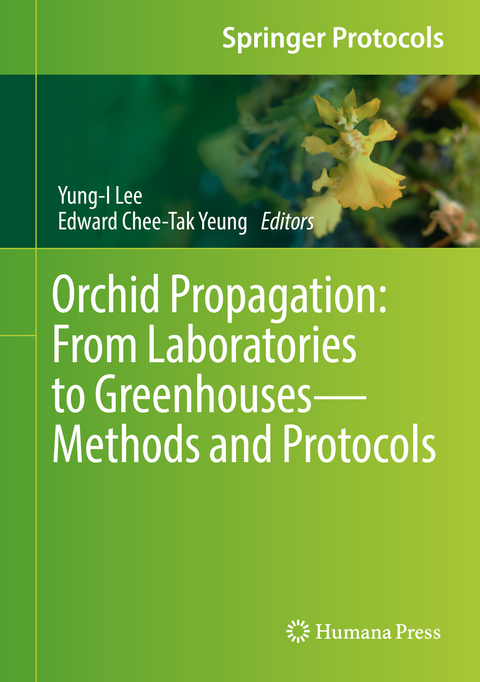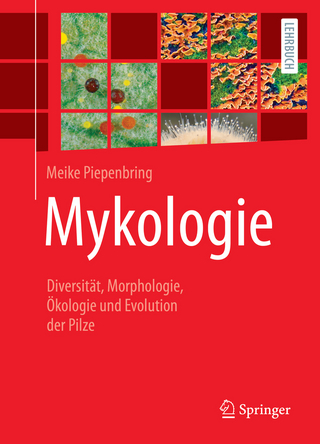
Orchid Propagation: From Laboratories to Greenhouses—Methods and Protocols
Humana Press Inc. (Verlag)
978-1-4939-7770-3 (ISBN)
Yung-I Lee received his Ph.D. degree in Horticultural Science from the National Taiwan University. After spending two years as a postdoctoral fellow at the Institute of Plant and Microbial Biology, Academia Sinica, Taiwan, Dr. Lee joined the Department of Biology, National Museum of Natural Science, where he is now a Curator. His primary research interests have been the conservation biology of orchids, especially in vitro propagation and mycorrhizal association. Dr. Lee also served as the chairman of Orchid Working Group (2006-2010) in the International Society for Horticultural Science. Edward Chee-Tak Yeung received his B. Sc. Honors degree from the University of Guelph and a Ph.D. in Biology from Yale University. After spending one year as a postdoctoral fellow at the University of Ottawa, Dr. Yeung joined the Department of Biological Sciences, University of Calgary, Canada, where he is now a Faculty Professor. His primary research interests involvethe reproductive biology of higher plants, especially the structural and physiological aspects of embryo development. Professor Yeung is the recipient of the Lawson Medal in recognition of cumulative, life-time contributions to Canadian botany from the Canadian Botanical Association in 2014. He has co-edited two books with colleagues, entitled “Plant Embryo Culture” and “Plant Microtechniques and Protocols”. Both are published by Springer Nature, New York.
Part I: Orchid Seeds in Plant Propagation and Conservation.- Understanding Seed and Protcorm Development in Orchids.- Orchid Mycorrhizal Fungi: Isolation and Identification Techniques.- Protocols for Establishing Fungi-Protocorm Culture.- Orchid Seed and Pollen: A Tool-kit for Long-term Storage, Viability Assessment and Conservation.- Part II: Orchid Micropropagation.- Orchid Seed Germination and Micropropagation I: Background information and Related Protocols.- Orchid Seed Germination and Micropropagation II: Media information and Composition.- Orchid Micropropagation: An Overview of Approaches and Methodologies.- Common Protocols in Orchid Micropropagation.- Micropropagation of Orchids by Using Bioreactor Technology.- Enhanced Growth and Development of Cymbidium and Phalaenopsis Plantlets Cultured in vitro Under Light-emitting Diodes.- Part III: Special Techniques.- Tracking Pollen Fates in Orchid Populations.- Cut-column Pollination Method to Overcome Pollination Barrier in Phalaenopsis.- In vitro Flowering and Breeding of Erycina pusilla.- Virus Elimination through Meristem Culture and Rapid Clonal Propagation Using a Temporary Immersion System.- Cryopreservation.- Haploid Seed Formation via Parthenogenesis in Bletilla.- A Protocol for the Induction of Polyploids in Phalaenopsis Orchids by in vitro Method without Using Anti-microtubule Agents.- Virus Detection.- Part IV: Cell and Molecular Biology and Transformation.- Genetic Transformation on Orchid species: An Overview of Approaches and Methodologies.- Recent Protocols on Genetic Transformation of Orchid Species.- The Use of Laser Microdissection to Investigate Cell Specific Gene Expression in Orchid Tissues.- Part V: Orchid Propagation and Maintenance.- Vegetative Propagation of Orchids.- Orchid Cultivation in Taiwan: Conventional and Innovative Methods.- Strategies in Orchid Health Maintenance.- Part VI: Showcasing Orchids.- Macro Flower Photography: An Introduction to Photographic Principles and Techniques.- An Introduction to Chinese Orchid Paintings.- Recent Advances in Orchid Seed Germination and Micropropagation.
| Erscheinungsdatum | 14.05.2018 |
|---|---|
| Reihe/Serie | Springer Protocols Handbooks |
| Zusatzinfo | 134 Illustrations, color; 17 Illustrations, black and white; XI, 524 p. 151 illus., 134 illus. in color. |
| Verlagsort | Totowa, NJ |
| Sprache | englisch |
| Maße | 178 x 254 mm |
| Themenwelt | Naturwissenschaften ► Biologie ► Botanik |
| Weitere Fachgebiete ► Land- / Forstwirtschaft / Fischerei | |
| Schlagworte | conservation • greenhouse techniques • orchid micropropagation • Orchid seed biology • orchid transformation |
| ISBN-10 | 1-4939-7770-9 / 1493977709 |
| ISBN-13 | 978-1-4939-7770-3 / 9781493977703 |
| Zustand | Neuware |
| Informationen gemäß Produktsicherheitsverordnung (GPSR) | |
| Haben Sie eine Frage zum Produkt? |
aus dem Bereich


